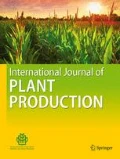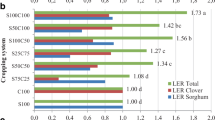Abstract
Multipurpose intercropping, as a way of agricultural intensification, would contribute to solving the food and feed shortage problems facing the developing countries. In Northern Egypt, a 2-year field study was conducted to investigate the forage potential, in terms of productivity and quality, of thinned sunflower and soybean intercrops, that were subjected to three nitrogen (N) fertilizer rates (70, 105, 140 kg N ha−1) and three ages at forage removal (thinning); 15, 30, and 45 days after sowing (DAS) for sunflower, and 30, 45, and 60 DAS, for soybean. Altering N rate exerted limited effect on the studied sunflower and soybean forage parameters. Dry matter (DM) content of sunflower (157.14 g kg−1) and crude protein (CP) content of sunflower (120.48 g kg−1) and soybean (162.49 g kg−1) were significantly increased, while soybean NDF content significantly decreased, with increasing the N rate. The effect of age at forage removal was more pronounced as it is a direct reflection to the crop’s stage of maturity at cutting. Older sunflower and soybean plants were characterized by higher herbage yield, DM and fiber contents, yet lower CP than younger plants. Maximum herbage yield achieved with late cutting of sunflower and soybean amounted to 9.82 and 10.81 t ha−1, respectively. Relative feed value of sunflower and soybean herbage was less stable in response to the variations in the studied treatments, while, relative forage quality resulting from all treatments was graded as “premium”, making them suitable for high-producing dairy cows and young calves in intensive dairy production systems.





Similar content being viewed by others
References
Acikögz, E., Sincik, M., Wietgrefe, G., Slürmen, M., Cecen, S., Yavuz, T., et al. (2013). Dry matter accumulation and forage quality characteristics of different soybean genotypes. Turkish Journal of Agriculture and Forestry, 37, 22–32.
Akin, D. E. (1989). Histological and physical factors affecting digestibility of forages. Agronomy Journal, 81, 17–25.
Ali, A. B., Altayeb, O. A., Alhadi, M., & Shuang-En, Y. (2014). Effect of different levels nitrogen and phosphorous fertilization on yield and chemical composition hybrid sunflower grown under irrigated conditions. Journal of Environmental and Agricultural Science, 1, 7.
Ali, H., Ahmad, S., & Muhammad, Y. (2004). Quantitative and qualitative traits of sunflower (Helianthus annuus L.) as influenced by planting dates and nitrogen application. International Journal of Agriculture and Biology, 6, 1–3.
Andrade, J. F., Cerrudo, A., Rizzalli, R. H., & Monzon, J. P. (2012). Sunflower–soybean intercrop productivity under different water conditions and sowing managements. Agronomy Journal, 104, 1049–1055.
AOAC International. (2012). Official methods of analysis (19th ed.). Gaithersburg: Association of Official Analytical Chemists.
Asekova, S., Shannon, J. G., & Lee, J.-D. (2014). The current status of forage soybean. Plant Breeding and Biotechnology, 2, 334–341.
Awais, M., Wajid, A., Ahmad, A., Saleem, M. F., Bashir, M. U., Saeed, U., Hussain, J., & Rahman, M. H. (2015). Nitrogen fertilization and narrow plant spacing stimulates sunflower productivity. Turkish Journal of Field Crops, 20, 99–108.
Bedoussac, L., Champclou, D., Tribouillois, H., Vericel, G., Lande, N., & Justes, E. (2013). Soybean intercropped with sunflower is an efficient solution to increase global grain production in low input systems. Legumes Perspectives, 1, 45–46.
Blount, A. R., Wright, D. L., Sprenkel, R. K., Hewitt, T. D., Hiebsch, C. K., & Myer, R. O. (2003). Forage soybeans for grazing. Florida: Hay and Silage.
Caffaro, S. V., & Nakayama, F. (1988). Vegetative activity of the main stem terminal bud under photoperiod and flower removal treatments in soybean. Australian Journal of Plant Physiology, 15, 475–480.
Chowdhury, M. K., & Rosario, E. L. (1992). Utilization efficiency of applied nitrogen as relayed to yield advantage in maize/mung bean intercropping. Field Crops Research, 30, 41–51.
De la Fuente, E. B., Suarez, S. A., Lenardis, A. E., & Poggio, S. L. (2014). Intercropping sunflower and soybean in intensive farming systems: Evaluating yield advantage and effect on weed and insect assemblages. NJAS-Wageningen Journal of Life Sciences, 70–71, 47–52.
Demirel, M., Bolat, D., Celik, S., Bakici, Y., & Celik, S. (2006). Quality of silages from sunflower harvested at different vegetational stages. Journal of Applied Animal Research, 30, 161–165.
Deniz, S., Nursoy, H., Ydmaz, Y., & Karsli, M. A. (2001). Effect of harvesting corn varieties at varying maturities on silage quality and digestible dry matter yield of corn silages. Veteriner Bilimleri Dergisi, 17, 43–49.
El-Kady, F. A., Awad, M. M., & Osman, E. B. A. (2010). Effect of nitrogen fertilizer rates and foliar fertilization on growth, yield, and yield components of sunflower. Journal of Plant Production, 1, 451–459.
Esau, K. (1977). Anatomy of seed plants (2nd ed.). New York: Wiley.
Esmail, S. H. M. (1991). Benefits of intercrops as feed sources for livestock. Rangelands, 13, 193–195.
Fehr, W. R., & Caviness, C. E. (1977). Stages of soybean development. Ames: Iowa State University.
Hanway, J. J., & Weber, C. R. (1971). Accumulation of N. P, and K by soybean (Glycin max (L.) Merrill) plants. Agronomy Journal, 63, 406–408.
Hintz, R. W., & Albrecht, K. A. (1994). Dry matter partitioning and forage nutritive value of soybean plant components. Agronomy Journal, 86, 59–62.
Hintz, R. W., Albrecht, K. A., & Oplinger, E. S. (1992). Yield and quality of soybean forage as affected by cultivar and management practices. Agronomy Journal, 84, 795–798.
Johnson, D. R., & Major, D. J. (1979). Harvest index of soybean as affected by planting date and maturity rating. Agronomy Journal, 71, 538–541.
Jung, H. J. G. (1997). Analysis of forage fiber and cell walls in ruminant nutrition. Journal of Nutrition, 127, 810S–813S.
Kamel, A. S. (2005). Intensive cropping in Egypt. Annals of Arid Zone, 44, 315–326.
Miller, M. D., Edwards, R. T., & Williams, W. A. (1973). Soybean for forage and green manure. In: B. H. Beard & P. F. Knowles (Eds.), Soybean research in California. (Vol. 862). pp. 60–66. California: Bulletin of the California Agricultural Experimental Station.
Moore, J. E., & Undersander, D. J. (2002a). Relative forage quality: A proposal for replacement for relative feed value. In: Proceedings National Forage Testing Association.
Moore, J. E., & Undersander, D. J. (2002b). Relative forage quality: An alternative to relative feed value and quality index. pp. 16–31. In: Proceedings 13th Annual Florida Ruminant Nutrition Symposium. January 10–11, University of Florida, Gainesville.
Nasim, W., Ahmad, A., Bano, A., Olatinwo, R., Usman, M., Khaliq, T., Wajid, A., Hammad, H. M., Mubeen, M., & Hussain, M. (2012). Effect of nitrogen on yield and oil quality of sunflower (Helianthus annuus L.) hybrids under sub humid conditions of Pakistan. American Journal of Plant Sciences, 3, 243–251.
Okoli, P. S., Drolsom, P. N., & Scholl, J. M. (1983). Forage production and weed control in a double-cropping program. Agronomy Journal, 76, 363–366.
Olowe, V. I. O., & Adebimpe, O. A. (2009). Intercropping sunflower with soybeans enhances total crop productivity. Biological Agriculture and Horticulture, 26, 365–377.
Oyinlola, E. Y., Ogunwole, J. O., & Amapu, I. Y. (2010). Response of sunflower (Helianthus annuus L.) to nitrogen application in a savanna alfisol. Helia, 33, 115–126.
Rohweder, D. A., Barnes, R. F., & Jorgensen, N. (1978). Proposed hay grading standards based on laboratory analyses for evaluating quality. Journal of Animal Science, 47, 747–759.
Salama, H. A. S. (2019). Yield and nutritive value of maize (Zea mays L.) forage as affected by plant density, sowing date and age at harvest. Italian Journal of Agronomy, 14, 114–122.
Salama, H. A. S., & Zeid, M. M. K. (2016). Hay quality evaluation of summer grass and legume forage monocultures and mixtures grown in Egypt. Australian Journal of Crop Science, 10, 1543–1550.
SAS Institute, Inc. (2012). SAS/STAT user’s guide, version 9.1. Cary: SAS Institute.
Schneiter, A. A., & Miller, J. F. (1981). Description of sunflower growth stages. Crop Science, 21, 901–903.
Sheaffer, C. C., Marten, G. C., Jordan, R. M., & Ristau, E. A. (1992). Sheep performance during grazing of annual forages in a double cropping system. Journal of Production Agriculture, 5, 33–37.
Sheaffer, C. C., Orf, J. H., Devine, T. E., & Jewett, J. G. (2001). Yield and quality of forage soybean. Agronomy Journal, 93, 99–106.
Van Soest, P. J., Robertson, J. B., & Lewis, B. A. (1991). Methods for dietary fiber, neutral detergent fiber, and nonstarch polysaccharides in relation to animal nutrition. Journal of Dairy Science, 74, 3583–3597.
Winer, B. J. (1971). Statistical principles in experimental design. (2nd ed). Tokyo: McGraw-Hill Kogakusha, LTD.
Funding
The authors received no financial support for the research, authorship, and/or publication of this article.
Author information
Authors and Affiliations
Corresponding author
Ethics declarations
Conflict of interest
The authors declared no potential conflicts of interest with respect to the research, authorship, and/or publication of this article.
Additional information
Publisher's Note
Springer Nature remains neutral with regard to jurisdictional claims in published maps and institutional affiliations.
Rights and permissions
About this article
Cite this article
Salama, H.S.A., Khalil, H.ES. & Nawar, A.I. Utilization of Thinned Sunflower and Soybean Intercrops as Forage: A Useful Strategy for Small Scale Farms in Intensive Agricultural Systems. Int. J. Plant Prod. 14, 487–499 (2020). https://doi.org/10.1007/s42106-020-00099-0
Received:
Revised:
Accepted:
Published:
Issue Date:
DOI: https://doi.org/10.1007/s42106-020-00099-0




